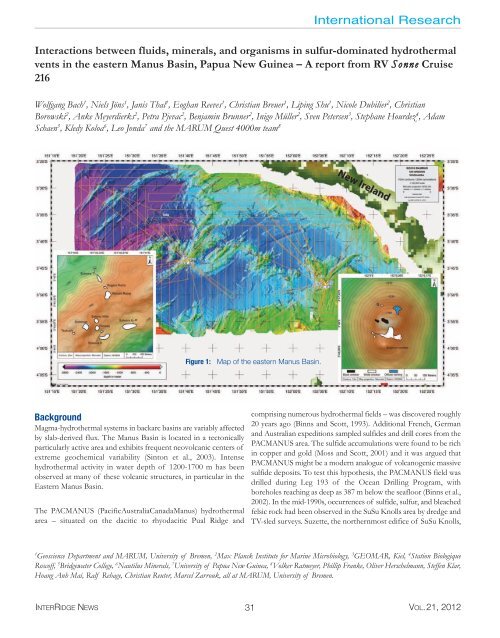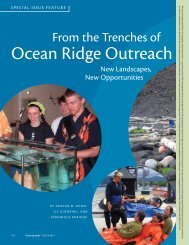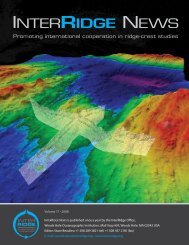Full version, low resolution, 7.5MB - InterRidge
Full version, low resolution, 7.5MB - InterRidge
Full version, low resolution, 7.5MB - InterRidge
Create successful ePaper yourself
Turn your PDF publications into a flip-book with our unique Google optimized e-Paper software.
International Research<br />
Interactions between fluids, minerals, and organisms in sulfur-dominated hydrothermal<br />
vents in the eastern Manus Basin, Papua New Guinea – A report from RV Sonne Cruise<br />
216<br />
Wolfgang Bach 1 , Niels Jöns 1 , Janis Thal 1 , Eoghan Reeves 1 , Christian Breuer 1 , Liping Shu 1 , Nicole Dubilier 2 , Christian<br />
Borowski 2 , Anke Meyerdierks 2 , Petra Pjevac 2 , Benjamin Brunner 2 , Inigo Müller 2 , Sven Petersen 3 , Stephane Hourdez 4 , Adam<br />
Schaen 5 , Kledy Koloa 6 , Leo Jonda 7 and the MARUM Quest 4000m team 8<br />
Figure 1:<br />
Map of the eastern Manus Basin.<br />
Background<br />
Magma-hydrothermal systems in backarc basins are variably affected<br />
by slab-derived flux. The Manus Basin is located in a tectonically<br />
particularly active area and exhibits frequent neovolcanic centers of<br />
extreme geochemical variability (Sinton et al., 2003). Intense<br />
hydrothermal activity in water depth of 1200-1700 m has been<br />
observed at many of these volcanic structures, in particular in the<br />
Eastern Manus Basin.<br />
The PACMANUS (PacificAustraliaCanadaManus) hydrothermal<br />
area – situated on the dacitic to rhyodacitic Pual Ridge and<br />
comprising numerous hydrothermal fields – was discovered roughly<br />
20 years ago (Binns and Scott, 1993). Additional French, German<br />
and Australian expeditions sampled sulfides and drill cores from the<br />
PACMANUS area. The sulfide accumulations were found to be rich<br />
in copper and gold (Moss and Scott, 2001) and it was argued that<br />
PACMANUS might be a modern analogue of volcanogenic massive<br />
sulfide deposits. To test this hypothesis, the PACMANUS field was<br />
drilled during Leg 193 of the Ocean Drilling Program, with<br />
boreholes reaching as deep as 387 m be<strong>low</strong> the seafloor (Binns et al.,<br />
2002). In the mid-1990s, occurrences of sulfide, sulfur, and bleached<br />
felsic rock had been observed in the SuSu Knolls area by dredge and<br />
TV-sled surveys. Suzette, the northernmost edifice of SuSu Knolls,<br />
1<br />
Geoscience Department and MARUM, University of Bremen, 2 Max Planck Institute for Marine Microbiology, 3 GEOMAR, Kiel, 4 Station Biologique<br />
Roscoff, 5 Bridgewater College, 6 Nautilus Minerals, 7 University of Papua New Guinea, 8 Volker Ratmeyer, Phillip Franke, Oliver Herschelmann, Steffen Klar,<br />
Hoang Anh Mai, Ralf Rehage, Christian Reuter, Marcel Zarrouk, all at MARUM, University of Bremen.<br />
INTERRIDGE NEWS 31 VOL.21, 2012
















